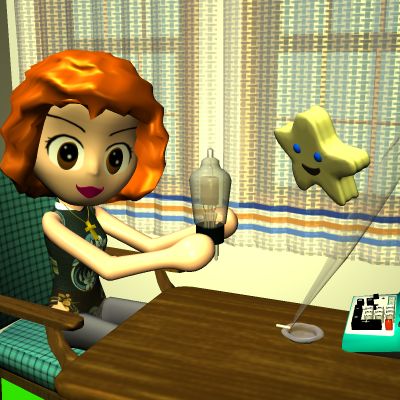Wednesday, April 04, 2012
How quickly knowledge disappears
The semi-humorous 'Feedback' column in the latest New Superstitionist contains a fine example of how old technology can be totally forgotten and misunderstood.
Okay, I see the basic arithmetic error. Should be a factor of 1600. Fine.
But why in hell would you think 500 kilocycles is "rather large for a system using valves"?

500 KC was already super-easy for tubes in the 1920's. By the '50s, commonly available tubes were routinely generating precise waveforms at 800 megacycles, the same clock freq as the new Chinese-slave-built Apple iWhatevers.
Specifically, 800 MC was within the bandwidth of UHF TV channel 69, which was not even the top channel. Channel 83 was 896 MC. Many American homes had UHF converters or UHF televisions in the mid-1950s.
So: If the LEO computer kept its clock speed down to 500 KC, it most certainly wasn't because of frequency limitations of tubes. More likely because of near-zero memory to store results. Beyond a certain speed the output will be too fast to read or print.
The limitation of tubes was not speed but complexity. A super-simple calculator requires at least two dozen switching elements, and serious computers require millions of switching elements. Two dozen full-sized tubes is about the limit for a device you can keep in a house or office; it could be stretched to two hundred with miniature 'hearing-aid' tubes. Beyond that you're getting into rooms full of racks, requiring vast air conditioners. A million tubes would be completely impossible.
Polistra is showing a typical triode from the '30s, which could handle about 50 MC, the clock speed of a high-end PC in 1990.
FINALLY, Allan Reese sends his application for membership of the Society for the Promotion of Numerate Proofreading (6 August 2011). He supports it with a story from London's Daily Telegraph on the 50th anniversary of the LEO I, the general-purpose business computer developed by J. Lyons & Co, which owned tea shops throughout the UK in the 1950s.
A factoid box in the article proclaims that the clock speed of the LEO was 0.5 MHz and that of an iPhone 4S model is 800 MHz. It goes on to explain that "the iPhone is faster by a factor of 16,000".
It is possible, though, that it is not just this number that is too high. Feedback and Allan both consider a speed of 0.5 MHz rather large for a system built with thermionic valves. We find the figure repeated dozens of times in very similar phrasing in numerous internet sites, such as the Wikipedia entry for LEO I. Could it be that a mistyped number has proliferated wildly thanks to LEO's successors?
Okay, I see the basic arithmetic error. Should be a factor of 1600. Fine.
But why in hell would you think 500 kilocycles is "rather large for a system using valves"?

500 KC was already super-easy for tubes in the 1920's. By the '50s, commonly available tubes were routinely generating precise waveforms at 800 megacycles, the same clock freq as the new Chinese-slave-built Apple iWhatevers.
Specifically, 800 MC was within the bandwidth of UHF TV channel 69, which was not even the top channel. Channel 83 was 896 MC. Many American homes had UHF converters or UHF televisions in the mid-1950s.
So: If the LEO computer kept its clock speed down to 500 KC, it most certainly wasn't because of frequency limitations of tubes. More likely because of near-zero memory to store results. Beyond a certain speed the output will be too fast to read or print.
The limitation of tubes was not speed but complexity. A super-simple calculator requires at least two dozen switching elements, and serious computers require millions of switching elements. Two dozen full-sized tubes is about the limit for a device you can keep in a house or office; it could be stretched to two hundred with miniature 'hearing-aid' tubes. Beyond that you're getting into rooms full of racks, requiring vast air conditioners. A million tubes would be completely impossible.
Polistra is showing a typical triode from the '30s, which could handle about 50 MC, the clock speed of a high-end PC in 1990.
